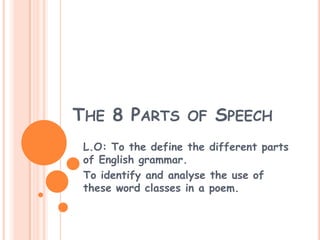
Terminology_Parts of Speech
- 1. THE 8 PARTS OF SPEECH L.O: To the define the different parts of English grammar. To identify and analyse the use of these word classes in a poem.
- 2. USE THE WORDS TO FILL IN THE GAPS PARTS OF SPEECH climb. When run Talk how On silently below. above, Place thing. Amsterdam Until, Walk there. Where but Now so person, Paula It she string. although. unless, because he, we you, they Robbie’s hair l, Short brown.
- 3. PARTS OF SPEECH A noun is a person, place or thing. As Paula, Amsterdam or string. A pronoun for a noun you’ll see As l, he, she, it, they, you, we An adjective describes a noun As Robbie’s hair is short and brown. A verb tells that there’s something done As walk and talk and climb and run. An adverb tells when, how and where As now and silently and there. A preposition lets you know If something’s on above, below. Conjunctions join and, but, so, Until, because, unless, although.
- 4. NOUNS A noun is a person, a place, or a thing. Ex. Jimmy read a book in the park. Jimmy is a noun because it is a person’s name. Book is a noun because it is a thing. Park is a noun because it is a place. Quit
- 5. THERE ARE DIFFERENT TYPES OF NOUNS: 1. An abstract noun names an idea, event, quality, or concept (freedom, love, courage...) Concrete nouns name something recognizable through the sense (table, dog, house...) 2. Animate nouns refer to a person, animal, or other creature (man, elephant, chicken...) An inanimate noun refers to a material object (stone, wood, table...) 3. A collective noun describes a group of things or people as a unit (family, flock, audience...) 4. Common noun is the name of a group of similar things (table, book, window...) Proper nouns, however, refer to the name of a single person, place or thing (John, Joseph, London...) 5. Compound nouns refer to two or more nouns combined to form a single noun (sister-in-law, schoolboy, fruit juice) 6. Countable (or count) nouns have a singular and a plural form. In plural, these nouns can be used with a number- they can be counted. (friends, chairs, houses, boys...) Uncountable (or non count) nouns, however, can only be used in singular. They can't be counted. (money, bread, water, coffee...
- 6. PRONOUNS A pronoun is a word that takes the place of a noun. Ex. John rode on John’s tractor. New sentence: John rode on his tractor. His takes the place of John’s to make the sentence sound better. Quit
- 7. ADJECTIVES An adjective is a word that describes a noun. Ex. The tall man went into the restaurant. Tall is an adjective. It describes a noun, man. Quit
- 8. VERBS A verb is a word that shows what something or someone is doing. Ex. Mary sleeps on the couch. Sleeps is a verb because it shows what Mary does. Quit
- 9. ADVERBS An adverb can tell how, when, or where an action happened. Ex. Jason quickly read the book. How did Jason read? Quickly. Quit
- 10. CONJUNCTIONS Conjunctions connect words, phrases, clauses, or even entire sentences. Ex. Grapes are purple or green. Or is the conjunction. It connects purple and green. Quit
- 11. PREPOSITIONS Prepositions are words that specify place, direction or time. Ex. The ball rolled under the table. Under is a preposition because it specifies place. Quit
- 12. INTERJECTIONS Interjections express feelings or emotions. They are at the beginning of a sentence followed by ! or , Ex. Sorry, I didn’t mean to step on your toe. Sorry is an interjection. It is at the beginning of the sentence and it expresses a feeling. Quit
- 13. LABEL THESE: The cat sat on the mat The big, hairy, smelly cat slept soundly and snored on the old mat I will go to the shop and buy a big chocolate cake for Sammy A really nice place to go for holidays is a Greek island called Crete He always ran so they called him the running boy Darkness surrounded her. The anxiety began to build gradually, and a sense of desperation enveloped her…… He is always happy. He is the most happy dog in the world………
- 14. APPLICATION Nouns Pronouns Adjectives Verbs Adverbs Conjunctions Prepositions Interjections Try to find an example of each of these word classes in the poem Ozymandias.
- 15. LANG LIT ANALYSIS Get into six different groups. Each group needs to analyse the features from the poem in the section they have been given. Use the relevant terminology and the cone framework to help you know what to look for in your area.
